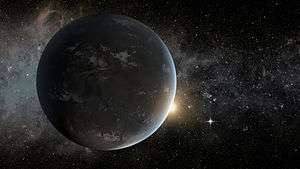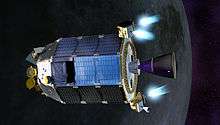Kepler-69c
| Exoplanet | List of exoplanets | |
|---|---|---|
 | ||
| Parent star | ||
| Star | Kepler-69 | |
| Constellation | Cygnus[1] | |
| Right ascension | (α) | 19h 33m 02.622s[2] |
| Declination | (δ) | +44° 52′ 08.00″[2] |
| Apparent magnitude | (mV) | 13.7[3] |
| Distance | 2700[4] ly (830 pc) | |
| Spectral type | G4V[5] | |
| Mass | (m) | 0.81 (± 0.1)[3] M☉ |
| Radius | (r) | 0.93 (± 0.02)[3] R☉ |
| Temperature | (T) | 5638 (± 138)[3] K |
| Metallicity | [Fe/H] | −0.540[6] |
| Age | 0.4[2] Gyr | |
| Physical characteristics | ||
| Mass | (m) | ~6 M⊕ |
| Radius | (r) | 1.71+0.34 −0.23[3] R⊕ |
| Stellar flux | (F⊙) | 1.91 (+0.43 −0.56)[7] ⊕ |
| Temperature | (T) | 548 K (275 °C; 527 °F)[note 1] |
| Orbital elements | ||
| Semi-major axis | (a) | 0.64+0.15 −0.11[2][6] AU |
| Eccentricity | (e) | 0.14+0.18 −0.1[2][6] |
| Orbital period | (P) | 242.4613 (± 0.006)[2][3][6] d |
| Inclination | (i) | 89.85+0.03 −0.08[2][6]° |
| Time of transit | (Tt) | 150.867[2][6] JD |
| Discovery information | ||
| Discovery date | 18 April 2013 | |
| Discoverer(s) | Kepler spacecraft | |
| Discovery method | Transit (Kepler Mission Method) | |
| Discovery status | Conference announcement | |
| Other designations | ||
| KOI-172.02, 2MASS J19330262+4452080, KIC 8692861 | ||
| Database references | ||
| Extrasolar Planets Encyclopaedia | data | |
| SIMBAD | data | |
| Exoplanet Archive | data | |
| Open Exoplanet Catalogue | data | |
Kepler-69c[3][8][9] (also known by its Kepler Object of Interest designation KOI-172.02)[6][10] is a confirmed super-Earth extrasolar planet, likely rocky, orbiting the Sun-like star Kepler-69, the outermost of two such planets discovered by NASA's Kepler spacecraft. It is located about 2,700 light-years (830 parsecs, or nearly 2.5544×1016 km) from Earth in the constellation of Cygnus. The exoplanet was found by using the transit method, in which the dimming effect that a planet causes as it crosses in front of its star is measured. Initial discovery of the planet was announced on January 7, 2013;[5][11] confirmation was announced on April 18, 2013. Although it was initially thought to be in the habitable zone,[12] it is now thought to represent a super-Venus, analogous to Venus but more massive, and thus highly unlikely to be habitable for life.[13]
Characteristics
Mass, radius and temperature
Kepler-69c is a super-Earth, an exoplanet that has a radius and mass larger than Earth, but smaller than that of the ice giants Uranus and Neptune. It has a surface temperature of 548 K (275 °C; 527 °F). It has an estimated mass of around 6 M⊕, and a radius of 1.71 R⊕. These characteristics make it an analog to Venus, but more massive, so it is called a "super-Venus".
Host star
The planet orbits a (G-type) star named Kepler-69, orbited by a total of two planets. The star has a mass of 0.81 M☉ and a radius of 0.93 R☉. It has a surface temperatures of 5638 K and has an estimated age of around 400 million years, meaning it has probably finished planet formation. In comparison, the Sun is about 4.6 billion years old[14] and has a surface temperature of 5778 K.[15]
The star's apparent magnitude, or how bright it appears from Earth's perspective, is 13.7.[3] Therefore, Kepler-69 is too dim to be seen with the naked eye.
Orbit
Kepler-69c orbits its host star with about 80% of the Sun's luminosity every 242 days at a distance of 0.64 times that of Earth. This is very similar to that of Venus's orbital period and distance in the Solar System.
Proposed habitability

The exoplanet, along with the exoplanets Kepler-62e and Kepler-62f, were announced in the media as being located within the star's "habitable zone", a region where liquid water could exist on the surface of the planet. It was described as being one of the most Earth-like planets, in terms of size and temperature yet found and, according to the scientists, a "prime candidate to host alien life".[5]
Due to uncertainties in the stellar parameters, the error bars on the value of the incident flux on this planet are quite large, at 1.91+0.43
−0.56 times the level of Earth. Using the nominal parameters, the planet is too close to the star to be habitable, though the uncertainties allow for the possibility that it may actually lie in the innermost region of the habitable zone,[16] however even with the lowest error bar measurement, a stellar flux of 1.35 S⊕ would still be high enough to boil away any oceans. A more recent analysis has shown that the planet is likely more analogous to Venus, which is known to be one of the most inhospitable places to life in the Solar System, and thus highly unlikely to be habitable to such organisms.[13]
The planet would be inhospitable because of a runaway greenhouse effect on its surface. Any oceans on its surface would've boiled away due to the high stellar flux, and as this occurred, the temperature would've risen to around 322 K (49 °C; 120 °F). The water vapor would've accumulated in the atmosphere to the point where the surface temperature would rise to around 500 K (227 °C; 440 °F) as the planet would've been overwhelmed by water vapor (it is a powerful greenhouse gas).[17] Little amounts of carbon dioxide would've been present, as Kepler-69c was probably an ocean planet (with little to no landmasses) very shortly after its star was born into the main sequence, before the stellar flux increased to its estimated present value. The surface pressure would've also increased to around 100 times Earth's surface pressure (100 kilopascals, 100 atm.) because of the amount of water vapor in the atmosphere.
Discovery
In 2009, NASA's Kepler spacecraft was completing observing stars on its photometer, the instrument it uses to detect transit events, in which a planet crosses in front of and dims its host star for a brief and roughly regular period of time. In this last test, Kepler observed 50000 stars in the Kepler Input Catalog, including Kepler-69; the preliminary light curves were sent to the Kepler science team for analysis, who chose obvious planetary companions from the bunch for follow-up at observatories. Observations for the potential exoplanet candidates took place between 13 May 2009 and 17 March 2012. After observing the respective transits, which for Kepler-69c occurred roughly every 242 days (its orbital period), it was eventually concluded that a planetary body was responsible for the periodic 242-day transits. The discovery, along with the planetary system of the star Kepler-62 were announced on April 18, 2013.[3]
On 9 May 2013, a congressional hearing by two U.S. House of Representatives subcommittees discussed "Exoplanet Discoveries: Have We Found Other Earths?," prompted by the discovery of exoplanet Kepler-69c, along with Kepler-62e and Kepler-62f. A related special issue of the journal Science, published earlier, described the discovery of the exoplanets.[18]
| Notable Exoplanets – Kepler Space Telescope | |
|---|---|
 Comparison of the sizes of planets Kepler-69c, Kepler-62e, Kepler-62f, and the Earth. Comparison of the sizes of planets Kepler-69c, Kepler-62e, Kepler-62f, and the Earth.Exoplanets are artists' impressions. |
 The Kepler Space Telescope search volume, in the context of the Milky Way Galaxy. The Kepler Space Telescope search volume, in the context of the Milky Way Galaxy. |
See also
References
- ↑ Walker, John (April 4, 2003). "Your Sky - The Virtual Telescope". fourmilab.ch. Retrieved January 13, 2013.
- 1 2 3 4 5 6 7 8 Staff (January 7, 2013). "Kepler KOI Search Results for KOI-172.02". Space Telescope Science Institute. Retrieved January 11, 2013.
- 1 2 3 4 5 6 7 8 9 Barclay, Thomas; et al. (2013). "A super-Earth-sized planet orbiting in or near the habitable zone around Sun-like star". The Astrophysical Journal. 768 (2): 101. arXiv:1304.4941
 . Bibcode:2013ApJ...768..101B. doi:10.1088/0004-637X/768/2/101.
. Bibcode:2013ApJ...768..101B. doi:10.1088/0004-637X/768/2/101. - ↑ Batalha, Natalie (January 17, 2013). "Astronomer, Kepler Space Observatory - Message Post". Facebook. Retrieved January 17, 2013.
- 1 2 3 Moskowitz, Clara (January 9, 2013). "Most Earth-Like Alien Planet Possibly Found". Space.com. Retrieved January 9, 2013.
- 1 2 3 4 5 6 7 Staff. "NASA Exoplanet Archive -KOI-172.02". Caltech. Retrieved January 11, 2013.
- ↑ Kaltenegger, L. "Water-Planets in the Habitable Zone: Atmospheric Chemistry, Observable Features, and the case of Kepler-62e and -62f". The Astrophysical Journal Letters. 775 (2): L47. arXiv:1304.5058
 . Bibcode:2013ApJ...775L..47K. doi:10.1088/2041-8205/775/2/L47.
. Bibcode:2013ApJ...775L..47K. doi:10.1088/2041-8205/775/2/L47. - ↑ Johnson, Michele; Harrington, J.D. (18 April 2013). "NASA's Kepler Discovers Its Smallest 'Habitable Zone' Planets to Date". NASA. Retrieved 18 April 2013.
- ↑ Overbye, Dennis (18 April 2013). "2 Good Places to Live, 1,200 Light-Years Away". New York Times. Retrieved 18 April 2013.
- ↑ Johnston, Wm. Robert (October 2, 2011). "List of Extrasolar Planets". JohnstonArchive.com. Retrieved January 11, 2013.
- ↑ Harrington, J. D.; Johnson, Michele (January 7, 2013). "NASA'S Kepler Mission Discovers 461 New Planet Candidates". NASA. Retrieved January 11, 2013.
- ↑ 3 Potentially Habitable 'Super-Earths' Explained (Infographic)
- 1 2 Kane, Stephen; et al. "A Potential Super-Venus in the Kepler-69 System". The Astrophysical Journal Letters. 770 (2): L20. arXiv:1305.2933
 . Bibcode:2013ApJ...770L..20K. doi:10.1088/2041-8205/770/2/L20.
. Bibcode:2013ApJ...770L..20K. doi:10.1088/2041-8205/770/2/L20. - ↑ Fraser Cain (16 September 2008). "How Old is the Sun?". Universe Today. Retrieved 19 February 2011.
- ↑ Fraser Cain (September 15, 2008). "Temperature of the Sun". Universe Today. Retrieved 19 February 2011.
- ↑ L. Kaltenegger; D. Sasselov; S. Rugheimer (2013). "Water Planets in the Habitable Zone: Atmospheric Chemistry, Observable Features, and the case of Kepler-62e and -62f". arXiv:1304.5058v1
 [astro-ph.EP].
[astro-ph.EP]. - ↑ http://csep10.phys.utk.edu/astr161/lect/venus/greenhouse.html
- ↑ Staff (3 May 2013). "Special Issue: Exoplanets". Science. Retrieved 18 May 2013.
Notes
- ↑ Based on improved models of Kepler-69c after it was found to be uninhabitable.
External links
| Wikimedia Commons has media related to Kepler Mission. |
- Kepler Mission – NASA.
- Kepler – Discoveries – Summary Table – NASA.
- The Habitable Zone Gallery
- Kepler – Discovery of New Planetary Systems (2013).
- Kepler – Tally of Planets/interactive (2013) – NYT.
- Video (02:27) – NASA Finds Three New Planets in "Habitable Zone" (04/18/2013).
- Kepler KOI Data Search.
- KOI-172.02 Data at Exoplanet Archive/Caltech
- KOI-172 Star on Star Finder/KPGraham
- Extrasolar Planets – Data/JohnstonArchive
Coordinates: ![]() 19h 33m 02.622s, +44° 52′ 08.00″
19h 33m 02.622s, +44° 52′ 08.00″


